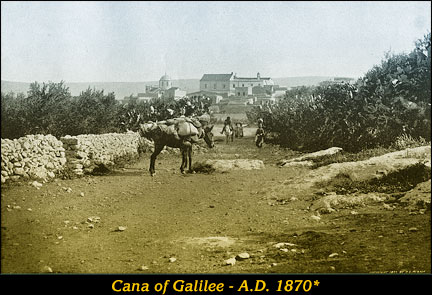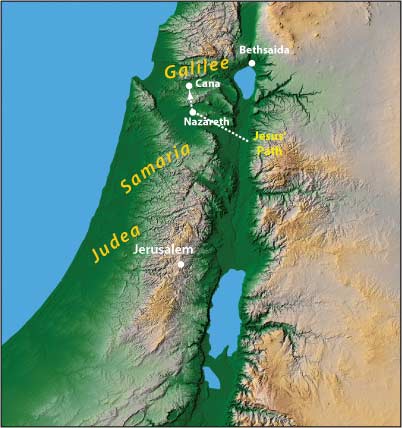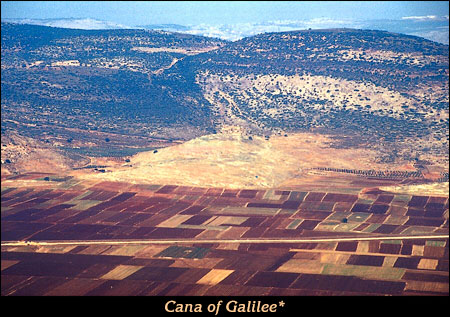Wedding in Cana of Galilee
from neverthirsty.org
How much does God love me? Have you ever asked yourself that question? I have asked myself that question at various times throughout my life during difficult situations. It is a question that will eventually come to one’s mind when the situation is dark and appears to be getting worse. When emotion swells up within and you feel like you are going to burst, the question is near, “Does anyone really care?” Like an automobile being pushed off a high cliff, the words finally fall from you lips or appear in your thoughts when you feel all alone, “Does anyone care? Does even God care?” This may seem like the wrong introduction to a study about a wedding in Cana of Galilee, but you will discover that this study answers these questions.
As we come to our study, Jesus and his five new disciples have traveled for about three days since He found Philip and Nathanael (John 1:43-51). Jesus has several followers now.
The Guests
We believe that the city of Cana that Jesus and His disciples visited was located about nine miles from Jesus’ boyhood town of Nazareth in Galilee.
The typical Jewish wedding in Jesus’ day was not preceded by a “live-together” arrangement. Today many young people are just living together and may decide to marry later. Some couples skip the dating part and just “hook-up.” But the Jewish people in Jesus’ day desired to obey God and consequently waited until marriage to engage in sexual relations.
The wedding would start when the bridegroom arrived at the bride’s home with his companions at night. Both the bridegroom and bride were crowned. They would be king and queen for a week. The bridegroom would then walk with his bride to his home, along with the bride’s father. They were joined by the bridegroom’s companions and others who carried lanterns to provide light during the walk. The processional included singing, the throwing of grain on the ground, and other activities.
When they arrived at the bridegroom’s home, the feast started. It could last as long as seven days. The feast included speeches, dancing, skipping, prayers, music, and of course food. At the end of the feast, the bride’s parents escorted her to the Nuptial Chamber where the bridegroom and bride had sexual relations. When they were finished, her parents were handed a blood stained cloth as proof that she was a virgin. Her parents would then show the wedding guests the blood on the cloth as proof that their daughter was a virgin. This is disgusting to us today, but in Jesus’ time weddings were legal contracts.
Legal Contract
The wedding contract required that the bride be a virgin. The contract often included the details of what would happen at the wedding as well as what would be provided at the feast. So it is not surprising that Jesus’ mother was concerned when the wine ran out.
The Miracle
The expression “my hour” occurs many times in the gospel of John (John 7:30; 8:20; 12:23, 27; 13:1; 17:1). Every time it occurs, it always refers to Jesus’ future death on the cross, and so it does here too! He was simply telling Mary that the timing was all wrong. Mary knew who Jesus was. She knew that He was the Messiah, and she probably realized that He was God. She was no longer a young woman holding a baby remembering the wonders of shepherds and magi or of a child talking with rabbis in Jerusalem. This time a distressed mother was also trying to help Him complete His ministry. So she had encouraged Him to do some significant work – to do a great miracle. But He said, “No!” His greater miracles would come later. This is a great lesson for us. God does not perform miracles just any time, according to our desires, or when we want them. God plans His miracles. Even though Jesus was unwilling to do exactly what Mary wanted, Jesus was still willing to help, and Mary knew it. Jesus did not submit Himself to her. He was no longer in subjection to her. He was no longer a child. So this anxious mother tells the servants to obey Him.
Some wonder what type of wine Jesus made. Was this real wine or grape juice? The Greek language gives us a clue. The Greek word translated as “drunk” actually means “to become intoxicated.” That is, Jesus made real wine – the real stuff. However, the wine of Jesus’ day was usually diluted with water. The mixture could be as high as 10 parts of water to one part of wine. It appears that the ratio was usually 3 or 4 parts of water to one part wine. When the mixture was one-to-one the wine was called “strong drink” (Isaiah 28:7). Only barbarians drank their wine without mixing it with water (Stein, Robert. Wine Drinking in New Testament Times. Christianity Today. June 20, 1975. pp. 9-11). Therefore, Jesus’ wine was much different from the wine we drink today. The alcohol content probably never exceeded that of beer. This was the first miracle that Jesus performed in His ministry.
One of the wonderful truths in this passage is not that Jesus did a miracle. It is that Jesus cared enough about the hosts of the feast to rescue them from social embarrassment and possibly legal trouble. He cared enough to make wine! He cared enough about the guests that He made the best wine. He cared enough about Mary’s distress that He rescued her. Have you ever wondered if God cares about the little things in our life such as what you drink? Have you ever been lonely and wondered if God cared about how you feel? Have you ever wondered if God just simply cared? The answer is found in the simple, little miracle of making water into wine. God cares about even the little things. Jesus turned water into wine! Conclusion
Just like Mary, we can come to Jesus and ask for help. He may make us wait. He might comfort us another way, but He will not disappoint us. If He cares about even the little things in my life, how much more the major events and crises. He cares about lonely feelings, and cuts on little fingers. He cares about the little things in your life; and when He does He displays His glory.
We believe that the city of Cana that Jesus and His disciples visited was located about nine miles from Jesus’ boyhood town of Nazareth in Galilee.
On the third day there was a wedding in Cana of Galilee, and the mother of Jesus was there; and both Jesus and His disciples were invited to the wedding. (NASB) John 2:1-2Since Khirbet Cana is about a three hour walk from Nazareth, it is possible that Jesus brought His five disciples home and was invited to the wedding at Cana. The Greek language implies that Mary, Jesus’ mother, was already there when Jesus and His five disciples arrived. It appears from the passage we are studying that Jesus’ mother had some type of responsibility at the wedding. So it would be natural for her to arrive early and help with the preparations.
 |
 |
The wedding contract required that the bride be a virgin. The contract often included the details of what would happen at the wedding as well as what would be provided at the feast. So it is not surprising that Jesus’ mother was concerned when the wine ran out.
When the wine ran out, the mother of Jesus said to Him, “They have no wine.” And Jesus said to her, “Woman, what does that have to do with us? My hour has not yet come.” (NASB) John 2:3-4Mary understood the serious social embarrassment and the potential legal implications. So she went to Jesus and said, “We have no wine!” She was in distress over this situation. It is possible that Mary might have had responsibility for the wine. That would have made the situation even more urgent to her. But apparently she also saw an opportunity for Jesus to let the wedding guests know that He was the Messiah. So Jesus responds with, “Woman, what does that have to do with us? My hour has not yet come.” In Jesus’ day “Woman” was an expression of respect. We can see that by the fact that while Mary was standing at the foot of the cross Jesus asked the Apostle John to care for her and called her “woman” (John 19:26). That was a soft, emotional moment and not a time of rebuke. Jesus did not rebuke her but simply told her that His time had not yet come.
 |
The expression “my hour” occurs many times in the gospel of John (John 7:30; 8:20; 12:23, 27; 13:1; 17:1). Every time it occurs, it always refers to Jesus’ future death on the cross, and so it does here too! He was simply telling Mary that the timing was all wrong. Mary knew who Jesus was. She knew that He was the Messiah, and she probably realized that He was God. She was no longer a young woman holding a baby remembering the wonders of shepherds and magi or of a child talking with rabbis in Jerusalem. This time a distressed mother was also trying to help Him complete His ministry. So she had encouraged Him to do some significant work – to do a great miracle. But He said, “No!” His greater miracles would come later. This is a great lesson for us. God does not perform miracles just any time, according to our desires, or when we want them. God plans His miracles. Even though Jesus was unwilling to do exactly what Mary wanted, Jesus was still willing to help, and Mary knew it. Jesus did not submit Himself to her. He was no longer in subjection to her. He was no longer a child. So this anxious mother tells the servants to obey Him.
His mother said to the servants, “Whatever He says to you, do it.” John 2:5 (NASB)Jesus was prepared to help, not according to Mary’s plan, but according to what fit the purpose of God. God does the same thing for each of us. We may be discouraged, feeling unloved, or feeling all alone, but Jesus has not ignored us. He may be saying, “Not yet! This is not the best time. “I will accomplish it another way.” God is in the business of answering our prayers. Sometimes the answer is, “No” and other times the answer is, “I will do it another way.” So Jesus tells the servants to fill six large waterpots.
Now there were six stone waterpots set there for the Jewish custom of purification, containing twenty or thirty gallons each. Jesus said to them, “Fill the waterpots with water.” So they filled them up to the brim. John 2:6-7 (NASB)The waterpots were able to hold twenty to thirty gallons (76-114 liters) of water each. It must have taken the servants a long time to fill them; but once they were filled, Jesus did His first miracle.
And He said to them, “Draw some out now and take it to the headwaiter.” So they took it to him. When the headwaiter tasted the water which had become wine, and did not know where it came from (but the servants who had drawn the water knew), the headwaiter called the bridegroom, and said to him, “Every man serves the good wine first, and when the people have drunk freely, then he serves the poorer wine; but you have kept the good wine until now.” John 2:8-10 (NASB)Jesus had turned the water into wine. Jesus’ Wine
Some wonder what type of wine Jesus made. Was this real wine or grape juice? The Greek language gives us a clue. The Greek word translated as “drunk” actually means “to become intoxicated.” That is, Jesus made real wine – the real stuff. However, the wine of Jesus’ day was usually diluted with water. The mixture could be as high as 10 parts of water to one part of wine. It appears that the ratio was usually 3 or 4 parts of water to one part wine. When the mixture was one-to-one the wine was called “strong drink” (Isaiah 28:7). Only barbarians drank their wine without mixing it with water (Stein, Robert. Wine Drinking in New Testament Times. Christianity Today. June 20, 1975. pp. 9-11). Therefore, Jesus’ wine was much different from the wine we drink today. The alcohol content probably never exceeded that of beer. This was the first miracle that Jesus performed in His ministry.
This beginning of His signs Jesus did in Cana of Galilee, and manifested His glory, and His disciples believed in Him. John 2:11 (NASB)Through it He displayed some of His glory. He let us see Himself. By this simple miracle, we are able to see not only His power but His heart. Little Things
One of the wonderful truths in this passage is not that Jesus did a miracle. It is that Jesus cared enough about the hosts of the feast to rescue them from social embarrassment and possibly legal trouble. He cared enough to make wine! He cared enough about the guests that He made the best wine. He cared enough about Mary’s distress that He rescued her. Have you ever wondered if God cares about the little things in our life such as what you drink? Have you ever been lonely and wondered if God cared about how you feel? Have you ever wondered if God just simply cared? The answer is found in the simple, little miracle of making water into wine. God cares about even the little things. Jesus turned water into wine! Conclusion
Just like Mary, we can come to Jesus and ask for help. He may make us wait. He might comfort us another way, but He will not disappoint us. If He cares about even the little things in my life, how much more the major events and crises. He cares about lonely feelings, and cuts on little fingers. He cares about the little things in your life; and when He does He displays His glory.
Credit Line: *Photograph(s) used by permission of BiblePlaces.com